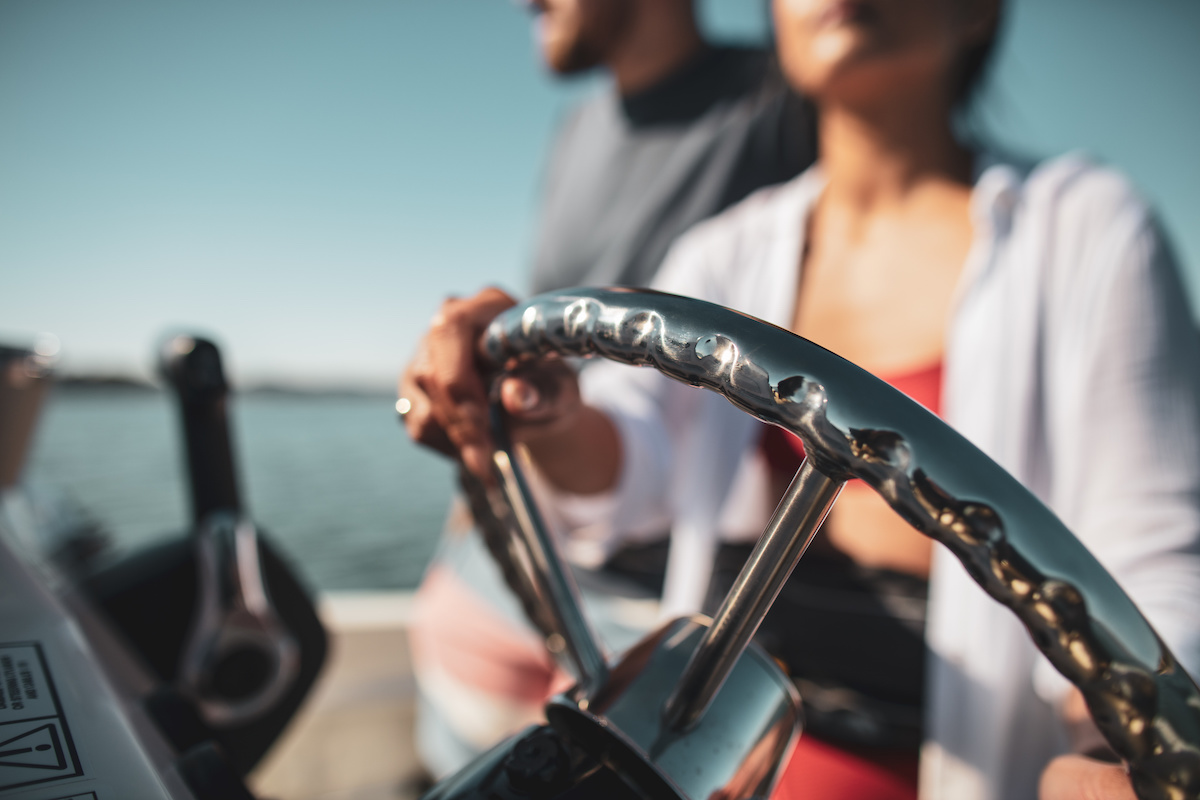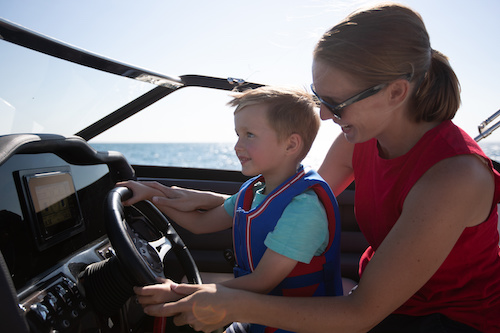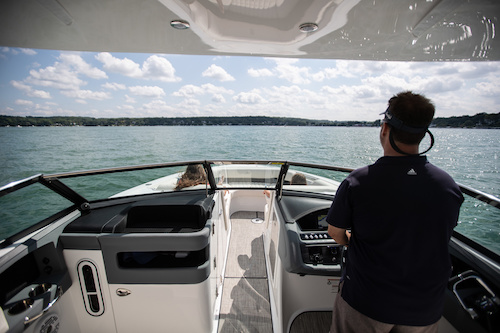So: you haven’t owned a boat before, but after discovering that the boating lifestyle is totally awesome (we agree!) you’ve began exploring our Boat Finder Tool—and luckily, you've found the ideal boat for you and your family. You’re probably thinking that your next big challenge will be learning how to drive that boat—and you’re right—but don’t let the prospect feel daunting.
Remember the first time you sat behind the wheel of a car? You may have experienced a bit of trepidation then, too. But you probably got over it in short order, and driving became second nature before you knew it. In all likelihood, you’ll have a similar experience as you learn how to drive your boat.
To get started, let’s boil it all down to the basics when it comes to learning how to drive a boat.
How to Drive a Boat
- If your boat is powered by gasoline and has an engine compartment, run the “blower” (an exhaust fan) as per manufacturer’s recommendations prior to starting the engine, to make sure there isn’t a build-up of fumes in the compartment. This is a good time to run through your Pre-Departure Checklist.
- Put the key into the ignition (some modern boats have push-buttons instead), and turn it to start the engine.
- If the boat has a “kill switch” (also known as an engine safety cut-off, which automatically turns the engine off if you leave the helm for any reason), clip the lanyard on a belt loop of life jacket ring.
- Make sure all your gear is aboard and all your passengers are prepared to disembark.
- Remove all the lines securing the boat to the dock, pier or slip.
- Engage forward (or reverse if you need to back out of a slip) by pushing the throttle handle forward (or pulling it back) gently until you feel it shift into gear.
- When the boat begins moving, spin the wheel just as you would turn the steering wheel in a car to determine direction of travel.
- Advance the throttle as appropriate to reach the desired speed.
- Trim (adjust running attitude) the boat as appropriate for the conditions.
- When you want to slow down, gently pull the throttle back towards the neutral position.
How to Start a Boat
Starting a boat is as simple as turning the key, but there are a few safety items you need to be aware of which aren’t present in automobiles and which may prevent the engine from turning over.
Engine Safety Cut-Off or "Kill Switch"
The first safety item that's important to note is one we mentioned above: the kill switch, or engine safety cut-off. This is a small red knob found next to the ignition on most small or open boats. In the closed position, the switch won’t allow the engine to start. A small clip fitted to slide under the knob pulls it back, into the open position. This clip is attached to a lanyard, which has a tether clip on the other end.You should always clip this onto a loop on your lifejacket or a belt loop, prior to operating your boat. Then, if for any reason you move away from the helm, the lanyard yanks the clip out from under the knob and the engine immediately stops.
Throttle
Another safety feature that can prevent a boat engine from starting is the throttle, which must be in the neutral position. If the boat battery is turned on and fully charged, you turn the key, and the engine doesn’t start, it’s often because the kill switch is engaged or the throttle isn’t in neutral.
Operating the Boat's Throttle
Think of a boat’s throttle just like the accelerator pedal in a car. Unlike a car, however, once you adjust it to a specific speed it stays there. So slowing down requires more than just taking your foot off a pedal, you have to actually grasp the throttle and pull it back. This is important to keep in mind, because when you see a large wave or lots of traffic coming, you need to be prepared to move the throttle accordingly.
This brings up an important point we haven’t covered just yet: situational awareness. When driving any motorized vehicle it’s important to constantly monitor your surroundings for anything that might require a response—a traffic light, pedestrians, other vehicles, and so on. The same is true when you’re operating a boat. In boating terms this is referred to as “maintaining a proper lookout,” and it means that as the captain of a boat, you have to always be watching your surroundings and recognize when there’s a risk of collision, running aground, hitting a big wave, or any other factor that could require a response at the helm.
Steering a Boat
As we pointed out, using a steering wheel on a boat is very similar to using a steering wheel in an automobile. You turn the wheel, and the boat follows—mostly.
You need to always remember that there are other factors influencing a boat’s direction of travel, like wind, waves, and current. As a result, boats may handle differently in different conditions and a turn of the wheel may not always change the boat’s direction exactly as planned. This can be particularly frustrating when docking, which many new boaters describe as one of the most challenging maneuvers to learn. So before you give it your first shot study up on the process, by reading Docking a Boat: a Step-by-Step Guide.
Once you have steering and docking down pat, you may be tempted into making long cruises to distant ports, or fishing hotspots that are beyond eyesight of the marina. To get there and back safely, you’ll need to take another big step in your boating career and learn how to navigate a boat.
Understanding Boating Right of Way Rules
Slowing a Boat
We already mentioned that you have to manipulate the throttle to get a boat to slow down, but since boats don’t have brakes, there’s a bit more you need to know.
- For starters, you need to become familiar with your boat and learn how much stopping distance is needed to come to a complete stop in a safe fashion when running at different speeds.
- Remember, boats don’t have seatbelts and are subject to a lot more motion than land vehicles. As a result, sudden or abrupt changes in speed or direction can throw people off balance or even cause them to fall overboard.
- Always be conscious of how you adjust speed or turn. In cases of quick maneuvers, when possible you’ll also want to shout out a warning to your passengers so they know to hold on.
All of that said, you can slow a boat fastest by:
- first pulling the throttle back to neutral;
- pausing for a moment;
- then shifting into reverse and applying some power.
Remember to always pause in neutral and don’t shift directly from forward into reverse, because quickly shifting from one to the other can cause mechanical damage in some boats.
It’s also important to note that there are many other aspects to driving a boat that relate to the safety of you and your passengers. That’s why most states require you to take a basic boating safety course before running your own boat. But on top of that, prior to operating one we strongly recommend visiting our Safety Guide and giving it a thorough read.
How to Trim a Boat
With the basics under your belt, you’ll want to learn some of the finer points of driving a boat that will help it run smoother and more efficiently. One important item to learn is how to trim a boat. Trimming consists or manipulating the outdrive’s angle or deploying “trim tabs” (small plates on the stern of the boat).
- How you trim it determines how high the bow rises in relation to the stern, and how level the boat does or does not run.
- Trim is different on every boat, so trial and error is the best way to learn how your own boat responds to changes in drive angle and/or using tabs.
- Also keep in mind that on smaller boats, shifts in weight distribution (such as a passenger moving from one area of the boat to another) can cause changes in trim.
Learn More: How to Trim a Boat
Driving Different Types of Boats
All boat models are more or less unique, but a few require some special attention. Pontoon boats, for example, have some unusual traits. So for people getting a ‘toon, we’ve got a How to Drive a Pontoon Boat article just for you. And obviously sailboats are very different from powerboats. If you’re about to become a sailor, be sure to check out Learning the Basics of Sailing.
One final word of advice: remember that all boats are different, and it takes some practice to learn how to drive any boat—even Captain Ahab would need to re-learn a thing or two when taking the helm of a new vessel. So don’t be discouraged if you hit a speed-bump or two as you learn how to run your boat. Because before you know it, driving it will become second nature.
Read Next: How to Drive a Pontoon Boat
You Might Also Like:



